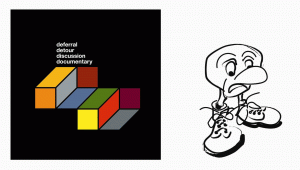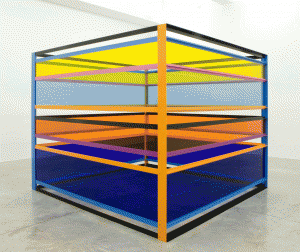« Features
Liam Gillick: Art and Functional Utopias

Liam Gillick, Three perspectives and a short scenario, 2008. Courtesy Liam Gillick / © Liam Gillick.
By Ernesto Menéndez-Conde
What is social about art is its intrinsic movement against societyTheodor Adorno, Aesthetic Theory (1)
This commune is a place in which the design of the trays is better than in the outside world.
Liam Gillick, Literally No Place (2)
During the last fifteen years, the British artist Liam Gillick has created parallels between his personal shows and his own writings. Many of his exhibitions have run simultaneously with the publishing of a book. Frequently, the books are included in the installations, along with flat-color panels, text sculptures, architectural structures, videos, and designs. For “Three Perspectives and a Short Scenario” -the retrospective currently showing at the Museum of Contemporary Art (MCA) of Chicago- there was the release of an anthology of essays titled Meaning Liam Gillick. Seventeen scholars attempted to define Gillick’s works, or offer hints for understanding his creations from a wide variety of topics. Meaning Liam Gillick somehow works as the catalog of the show. Even though this time Gillick’s texts were not included in the anthology, the parallelism of installations and writings remains the personal seal for his artistic events (the show at the MCA of Chicago was also accompanied by a curatorial project of the institution’s collection, also created by Gillick). Last year, while the retrospective was held in some European institutions (3), there was the release of All Books, a collection of the scripts and novels he has published since 1994.
For the artist himself, it is a mistake to over-determine this simultaneity (Gillick, 2006 167). Nevertheless, this parallelism seems to be a self-conscious artistic practice (Gillick 160-161) and it is at the core of his artistic production. The books are neither merely supplementary materials, nor incursions in a quite different field of creation. Gillick’s exhibitions, on the other hand, cannot be reduced just to his installations. Even if the artworks or books can be enjoyed as autonomous pieces, isolating Gillick’s artistic productions or underestimating the structure of the whole looks like a rather deceivable approach. The structure of his works seems to be precisely this parallelism between the writings and the visual images. He provokes the search for dialogue among the installations, novels, scripts, and essays he writes.

Liam Gillick, Three perspectives and a short scenario, 2008, installation at Witte de With, Center for Contemporary Art, Rotterdam. Courtesy of the artist. Photos by Bob Goedewaagen.
This peculiar practice turns Gillick into a hermetic artist since it raises the need to find connections among his whole set of creative productions. The viewer/reader is challenged to produce meanings through attempts to establish a coherent system from a variety of sources and means of expression. This task, which even seems difficult to avoid, is one of the most rewarding intellectual adventures in Gillick’s body of works. However, it looks as if the interpretation must remain open, since there is always room for conflictive points of views in the quest for unity or even parallelism among his heterogeneous fields of production. As Julian Stallabrass has asserted, “Gillick is an artist that offers possibilities rather than holds a position.(4)” Gillick’s works, seen in their simultaneity, are always metaphorical, suggestive, and even enigmatic.
However, it could be argued that this hermetic character is very eloquent in its own right, at least if interpreted the way Theodor Adorno understood the social resonance of art. As the author of the Aesthetic Theory noted:
“Hermetic works bring more criticism to bear on the existing than those that, in the interest of intelligible social criticism, devote themselves to conciliatory forms.” (145)
These words, written more than forty years ago, are still crucial in order to understand the possibilities of art as a mean of resistance in contemporary society. Actually they are particularly relevant today, in a Post Utopian World, when not only, as Adorno states, the direct treatment of social conflicts in artwork is the weakest, and most superfluous link between art and society (229), but also at a moment when tolerance has become genuinely repressive (Jameson 110), and the opposition to Neo-Liberalism seems to lead nowhere. The critique of Contemporary Capitalism lacks a social project, which somehow could be envisaged as a paradigm, or could provide a direction to the unconformity. Since the fall of Socialism in Eastern Europe, all progressive thinking risks being dismissed as “Communism,” or as reminiscent of a repressive, authoritarian Modernism.
In Gillick’s works, the criticism of Neo-Liberalism also implies a critique and a redefinition of Utopian thinking. In his novel, Literally No Place, he talks about grasping the “idea of a commune, a functional rationalistic commune that can really work and be productive” (Gillick, 2009 204). He also insists on being “communal, but not communistic” (Gillick, 2009 206). Some of his artistic experiments could lead to these types of experiences. Instead of Utopias, Gillick proposes developing the notion of “functional utopia,” which would be displayed throughout time, and would be intrinsic to the structure of the exhibition. A “functional utopia” is a participative one. It must create a “better place, and actually have a better time, rather than just providing soothing images of experimental architecture and a mish-mash of interactive structure” (Gillick, 2006 282). Instead of projections into the future, functional utopias are an alternative present. Art institutions themselves, while the exhibitions last, could be spaces for implementing these “functional utopias.” The collective show A Viable space: Der Umbau Raum (Klünterhous, Sttugart, 1996) -for which Gillick wrote a text and also participated as an artist- could provide an example of these attempts. In A Viable space, the artists were using the gallery as a site for research, hanging out, viewing and production (Gillick, 2006 103).

Liam Gillick, Rescinded Production, 2008. Collection Museum of Contemporary Art, Chicago. Gift of Mary and Earle Ludgin by exchange. Photo courtesy of Casey Kaplan Gallery, New York.
Functional utopias are in many ways related to Modernism, from Neo-plasticism to Bauhaus (some members of the Bauhaus movement, like Josef Albers, Kurt Schmith, and Marcel Breuer could be seen as precursors of Gillick’s installations), but the aims are quite different. Unlike Modernist conceptions, art is not pointing towards integration into life; it intends to maintain a critical distance from the social system.
By appealing to the hermetic, or by producing what the Spanish scholar Peio Aguirre has called “elusive social forms,(5)” Gillick takes advantage of artistic practices in order to create a social critique that also contains the conditions for exploring alternative means of social exchange. He places art in opposition to society, while, at the same time, conceiving it as a form of social consciousness.
Notes
1. Cited by Peter Bürguer in Theory of the Avant-Garde, University of Minnesota Press, Minneapolis, 2002: 10.
2. In All Books, London: Book Works, 2009: 205.
3.The title “Three Perspective and a Short Scenario” has to do with the institutions in which the exhibition was shown. It is an itinerant project which was presented at the Kunsthalle Zürich (January 25 to March 30, 2008), Witte de With in Rotterdam (January 19 to March 24, 2008), Kunstverein Munich (June to August 2008), and the Museum of Contemporary Art in Chicago (October 10, 2009 - January 10, 2010).
4. Cited by Chantal Mouffle, in Meaning Liam Gillick: 101.
5. See Peio Aguirre, “Social Elusive Forms,” in Meaning Liam Gillick: 1-27.
Works Cited
Adorno, W. Theodor. Aesthetic Theory. Minneapolis: University of Minnesota Press, 1997.
Gillick, Liam. Proxemics. Zurich-Dijon: JRP/Ringier & les Presses du R?el, 2006.
___________ All Books, London: Book Works, 2009.
Jameson, Fredric. Marxism and Form. Princeton University Press, 1971.
Szewczyk, Monika et al. Meaning Liam Gillick. Massachusetts, London: MIT Press, 2009.
Ernesto Menéndez-Conde. PhD in Latin American Literature from Duke University (2009). His field of research is related to Aesthetic Ideologies and Theories of the Image. He has collaborated with Sotheby’s (New York). He has published in magazines in New York, Spain, Havana, and Miami.


































